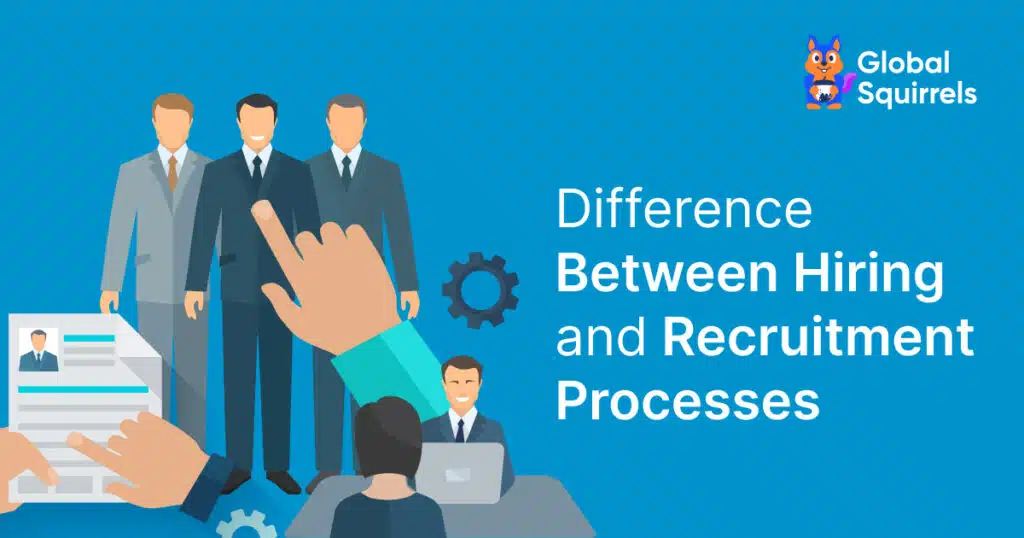Hiring vs Recruitment: The Ultimate Guide for Businesses

In the world of human resources and talent acquisition, two terms that are often used interchangeably but hold distinct meanings are “hiring” and “recruitment”. While they are both essential components of building a strong workforce, understanding the differences between these processes is crucial for organizations and job seekers alike. In this comprehensive guide, we will delve deep into the nuances that set hiring and recruitment apart, shedding light on their purposes, methods, and key distinctions. This article will focus on all key differences between the hiring and recruitment processes.
Key difference between hiring and recruitment processes
1. Definition of hiring and recruitment
2. Purpose of services
3. Timing of hiring and recruitment process
4. Scope
5. Methods of hiring and recruitment process
6. Assessment of candidates
7. Relationship building
8. Cost and resources
9. Measurement of success
Definition of hiring and recruitment
- Hiring: Hiring is the process that involves making a job offer, negotiating terms of employment, and formally bringing a candidate into the organization. It marks the final step in the process of bringing a new employee on board.
- Recruitment: Recruitment is a broader process that encompasses activities such as identifying, attracting, and assessing potential candidates, ultimately leading to the creation of a pool of qualified individuals to choose from during the hiring process. It is a continuous and ongoing effort that precedes hiring.
Purpose of services
- Hiring: The primary purpose of hiring is to fill an immediate job vacancy with a specific candidate who has been selected through the recruitment process. It serves the immediate staffing needs of the organization.
- Recruitment: Recruitment’s primary purpose is to build a talent pool, ensuring a continuous influx of potential candidates to meet current and future staffing needs. It’s a long-term, strategic approach to talent acquisition.
Related read: Employer of Record vs Staffing Agency: Differences
Timing of hiring and recruitment process
- Hiring: Hiring is all about the right here and right now. It occurs when there is a specific, immediate job opening within the organization that urgently needs to be filled. This process is reactive in nature, meaning it’s a direct response to a vacancy that has already occurred.
- Recruitment: Recruitment is the long-term game. It’s a proactive and continuous process that occurs regardless of any immediate job openings within the organization. In essence, its aim is to build a pipeline of potential talent, ensuring that the organization is well-prepared when the need for hiring arises.
Scope
- Hiring: Hiring is the final and specific step in talent acquisition, where the goal is to fill a particular job vacancy by selecting a candidate who fits that role perfectly. It’s like putting the last piece into a puzzle to complete the picture. Hiring is a tactical process because it’s very job-specific and focused.
- Recruitment: Recruitment, on the other hand, is a comprehensive and ongoing strategy to ensure a continuous supply of potential candidates. It’s like having a diverse collection of puzzle pieces, ready to fit into different pictures. Recruitment is strategic because it takes a long-term view, aiming to build a pool of talent that can be used for various job roles and organizational needs.
Methods of hiring and recruitment process
- Hiring: When it comes to hiring, the focus is on the final steps of selecting a candidate for a specific job. Methods include conducting job interviews to assess a candidate’s qualifications, checking references to verify their background and work history, and eventually extending job offers to the chosen candidates. It’s all about finding the right fit for the immediate role.
- Recruitment: Recruitment takes a more comprehensive approach, involving a range of methods and channels to source potential candidates. This includes activities like posting job openings on various platforms, utilizing talent acquisition software to manage candidate data, networking to build a pool of contacts, and proactively scouting for talent in the industry. It also encompasses employer branding efforts to make the organization more attractive to potential candidates. The goal is to create a diverse and robust talent pool for future hiring needs.
Assessment of candidates
- Hiring: The assessment of candidates during hiring is often focused on specific job-related qualifications and immediate suitability for a particular role. It aims to determine if a candidate is a good fit for the available position.
- Recruitment: Recruitment’s assessment is more about identifying a candidate’s potential, long-term suitability within the organization, and cultural fit. It considers a broader set of skills and qualifications, as candidates may not be matched with an immediate opening.
Relationship building
- Hiring: Relationship building in the hiring process is primarily with the chosen candidate, with the aim of convincing them to accept the job offer and become part of the organization.
- Recruitment: Recruitment involves building relationships with a wider network of potential candidates, even if they have yet to be hired. These relationships help maintain a talent pipeline for future needs.
Also Read : PEO vs EOR
Cost and resources
- Hiring: Hiring is a cost-effective process that generally requires fewer resources and costs as a result, it’s a targeted, one-time activity meant to fill a specific job opening. It’s like a surgical strike, focusing on immediate needs.
- Recruitment: Recruitment, on the other hand, is a continual investment in terms of time, effort, and resources. Organizations allocate these resources to maintain a robust recruitment strategy. It’s a marathon, not a sprint, involving ongoing activities to source, engage, and assess potential candidates to build a talent pipeline for future needs.
Measurement of success
- Hiring: Success in hiring is typically measured by evaluating the efficiency and effectiveness of filling specific job openings. Key metrics may include the time-to-fill, cost per hire, and candidate quality for specific positions.
- Recruitment: Success in recruitment is measured by the strength and depth of the talent pipeline, the organization’s ability to be adaptable to changing business needs, and the overall quality of candidates that are attracted over time. Key metrics may include the size and diversity of the candidate pool and the impact on long-term workforce planning.
Conclusion
In summary, hiring and recruitment processes are critical in the world of talent acquisition. Moreover, each has its own distinct purpose, methods, timing, and scope. Understanding the difference between these processes is essential for organizations and job seekers alike, as it enables them to develop a more strategic and effective approach to building and maintaining a talented workforce. Hiring focuses on immediate job placement. Recruitment takes a long-term view, creating a continuous pool of potential candidates for future staffing needs.
